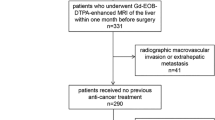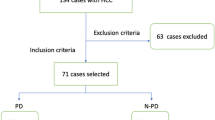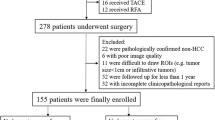Abstract
Purpose
Hepatocellular carcinoma (HCC) is the most common liver cancer worldwide, and early recurrence of HCC after curative hepatic resection is indicative of poor prognoses. We aim to develop a predictive model for postoperative early recurrence of HCC based on deep and radiomics features from multi-phasic magnetic resonance imaging (MRI).
Materials and methods
A total of 472 HCC patients were included and divided into the training (n = 378) and validation (n = 94) cohorts in the retrospective study. We separately extracted radiomics features and deep features from eight phases of gadoxetic acid-enhanced MRI and utilized the least absolute shrinkage and selection operator logistic regression algorithm for feature selection and model construction. We integrated the selected two types of features into a combined model and established a radiomics model as well as a deep learning (DL) model for comparison.
Results
In the training and validation cohorts, the combined model demonstrated better performance for stratifying patients at high risk of early recurrence (AUC of 0.911 and 0.840, accuracy of 0.779 and 0.777, sensitivity of 0.927 and 0.769, specificity 0.720 and 0.779) than the radiomics model (AUC of 0.740 and 0.780) and the DL model (AUC of 0.887 and 0.813).
Conclusion
The combined model integrating deep and radiomics features from multi-phasic MRI is efficient for noninvasively stratifying patients at high risk of early HCC recurrence after resection.






Similar content being viewed by others
Abbreviations
- AUC:
-
Area under the receiver operating characteristic curve
- BCLC:
-
Barcelona Clinic Liver Cancer
- CNN:
-
Convolutional neural network
- DCA:
-
Decision curve analysis
- DCNN:
-
Deep convolutional neural network
- DL:
-
Deep learning
- FC:
-
Fully connected
- HCC:
-
Hepatocellular carcinoma
- LASSO:
-
Least absolute shrinkage and selection operator
- MRI:
-
Magnetic resonance imaging
- NPV:
-
Negative predictive value
- PPV:
-
Positive predictive value
- RFS:
-
Recurrence-free survival
- ROC:
-
Receiver operating characteristic
- T2WI:
-
T2-weighted imaging
- VOI:
-
Volume of interest
References
Forner A, Reig M, Bruix J (2018) Hepatocellular carcinoma. Lancet 391(10127):1301–1314. https://doi.org/10.1016/S0140-6736(18)30010-2
Cheng Z, Yang P, Qu S, Zhou J, Yang J, Yang X, Xia Y, Li J, Wang K, Yan Z, Wu D, Zhang B, Huser N, Shen F (2015) Risk factors and management for early and late intrahepatic recurrence of solitary hepatocellular carcinoma after curative resection. HPB (Oxford) 17(5):422–427. https://doi.org/10.1111/hpb.12367
Tabrizian P, Jibara G, Shrager B, Schwartz M, Roayaie S (2015) Recurrence of hepatocellular cancer after resection: patterns, treatments, and prognosis. Ann Surg 261(5):947–955. https://doi.org/10.1097/SLA.0000000000000710
Choi GH, Kim DH, Kang CM, Kim KS, Choi JS, Lee WJ, Kim BR (2008) Prognostic factors and optimal treatment strategy for intrahepatic nodular recurrence after curative resection of hepatocellular carcinoma. Ann Surg Oncol 15(2):618–629. https://doi.org/10.1245/s10434-007-9671-6
Bruix J, Takayama T, Mazzaferro V, Chau GY, Yang J, Kudo M, Cai J, Poon RT, Han KH, Tak WY, Lee HC, Song T, Roayaie S, Bolondi L, Lee KS, Makuuchi M, Souza F, Berre MA, Meinhardt G, Llovet JM, investigators S (2015) Adjuvant sorafenib for hepatocellular carcinoma after resection or ablation (STORM): a phase 3, randomised, double-blind, placebo-controlled trial. Lancet Oncol 16 (13):1344–1354. doi:https://doi.org/10.1016/S1470-2045(15)00198-9
Dioguardi Burgio M, Ronot M, Fuks D, Dondero F, Cauchy F, Gaujoux S, Dokmak S, Paradis V, Durand F, Belghiti J, Vilgrain V (2015) Follow-up Imaging After Liver Transplantation Should Take Into Consideration Primary Hepatocellular Carcinoma Characteristics. Transplantation 99(8):1613–1618. https://doi.org/10.1097/TP.0000000000000659
Liu D, Fong DY, Chan AC, Poon RT, Khong PL (2015) Hepatocellular carcinoma: surveillance CT schedule after hepatectomy based on risk stratification. Radiology 274(1):133–140. https://doi.org/10.1148/radiol.14132343
Hao S, Fan P, Chen S, Tu C, Wan C (2017) Distinct recurrence risk factors for intrahepatic metastasis and multicenter occurrence after surgery in patients with hepatocellular carcinoma. J Gastrointest Surg 21(2):312–320. https://doi.org/10.1007/s11605-016-3311-z
Kamiyama T, Nakanishi K, Yokoo H, Kamachi H, Tahara M, Kakisaka T, Tsuruga Y, Todo S, Taketomi A (2012) Analysis of the risk factors for early death due to disease recurrence or progression within 1 year after hepatectomy in patients with hepatocellular carcinoma. World J Surg Oncol 10:107. https://doi.org/10.1186/1477-7819-10-107
Zhou J, Sun HC, Wang Z, Cong WM, Wang JH, Zeng MS, Yang JM, Bie P, Liu LX, Wen TF, Han GH, Wang MQ, Liu RB, Lu LG, Ren ZG, Chen MS, Zeng ZC, Liang P, Liang CH, Chen M, Yan FH, Wang WP, Ji Y, Cheng WW, Dai CL, Jia WD, Li YM, Li YX, Liang J, Liu TS, Lv GY, Mao YL, Ren WX, Shi HC, Wang WT, Wang XY, Xing BC, Xu JM, Yang JY, Yang YF, Ye SL, Yin ZY, Zhang BH, Zhang SJ, Zhou WP, Zhu JY, Liu R, Shi YH, Xiao YS, Dai Z, Teng GJ, Cai JQ, Wang WL, Dong JH, Li Q, Shen F, Qin SK, Fan J (2018) Guidelines for Diagnosis and Treatment of Primary Liver Cancer in China (2017 Edition). Liver Cancer 7 (3):235–260. doi:https://doi.org/10.1159/000488035
Kumar V, Gu Y, Basu S, Berglund A, Eschrich SA, Schabath MB, Forster K, Aerts HJ, Dekker A, Fenstermacher D, Goldgof DB, Hall LO, Lambin P, Balagurunathan Y, Gatenby RA, Gillies RJ (2012) Radiomics: the process and the challenges. Magn Reson Imaging 30(9):1234–1248. https://doi.org/10.1016/j.mri.2012.06.010
Zhou Y, He L, Huang Y, Chen S, Wu P, Ye W, Liu Z, Liang C (2017) CT-based radiomics signature: a potential biomarker for preoperative prediction of early recurrence in hepatocellular carcinoma. Abdom Radiol (NY) 42(6):1695–1704. https://doi.org/10.1007/s00261-017-1072-0
Kim S, Shin J, Kim DY, Choi GH, Kim MJ, Choi JY (2019) Radiomics on gadoxetic acid-enhanced magnetic resonance imaging for prediction of postoperative early and late recurrence of single hepatocellular carcinoma. Clin Cancer Res 25(13):3847–3855. https://doi.org/10.1158/1078-0432.CCR-18-2861
Zhang Z, Jiang H, Chen J, Wei Y, Cao L, Ye Z, Li X, Ma L, Song B (2019) Hepatocellular carcinoma: radiomics nomogram on gadoxetic acid-enhanced MR imaging for early postoperative recurrence prediction. Cancer Imaging 19(1):22. https://doi.org/10.1186/s40644-019-0209-5
Wen L, Weng S, Yan C, Ye R, Zhu Y, Zhou L, Gao L, Li Y (2021) A Radiomics nomogram for preoperative prediction of early recurrence of small hepatocellular carcinoma after surgical resection or radiofrequency ablation. Front Oncol 11:657039. https://doi.org/10.3389/fonc.2021.657039
Zhao Y, Wu J, Zhang Q, Hua Z, Qi W, Wang N, Lin T, Sheng L, Cui D, Liu J, Song Q, Li X, Wu T, Guo Y, Cui J, Liu A (2021) Radiomics analysis based on multiparametric MRI for predicting early recurrence in hepatocellular carcinoma after partial hepatectomy. J Magn Reson Imaging 53(4):1066–1079. https://doi.org/10.1002/jmri.27424
Shan QY, Hu HT, Feng ST, Peng ZP, Chen SL, Zhou Q, Li X, Xie XY, Lu MD, Wang W, Kuang M (2019) CT-based peritumoral radiomics signatures to predict early recurrence in hepatocellular carcinoma after curative tumor resection or ablation. Cancer Imaging 19(1):11. https://doi.org/10.1186/s40644-019-0197-5
Aerts HJ, Velazquez ER, Leijenaar RT, Parmar C, Grossmann P, Carvalho S, Bussink J, Monshouwer R, Haibe-Kains B, Rietveld D, Hoebers F, Rietbergen MM, Leemans CR, Dekker A, Quackenbush J, Gillies RJ, Lambin P (2014) Decoding tumour phenotype by noninvasive imaging using a quantitative radiomics approach. Nat Commun 5:4006. https://doi.org/10.1038/ncomms5006
LeCun Y, Bengio Y, Hinton G (2015) Deep learning. Nature 521(7553):436–444. https://doi.org/10.1038/nature14539
Le Berre C, Sandborn WJ, Aridhi S, Devignes MD, Fournier L, Smail-Tabbone M, Danese S, Peyrin-Biroulet L (2020) Application of Artificial Intelligence to Gastroenterology and Hepatology. Gastroenterology 158 (1):76–94. doi:https://doi.org/10.1053/j.gastro.2019.08.058
Song D, Wang Y, Wang W, Wang Y, Cai J, Zhu K, Lv M, Gao Q, Zhou J, Fan J, Rao S, Wang M, Wang X (2021) Using deep learning to predict microvascular invasion in hepatocellular carcinoma based on dynamic contrast-enhanced MRI combined with clinical parameters. J Cancer Res Clin Oncol. https://doi.org/10.1007/s00432-021-03617-3
Ning Z, Luo J, Li Y, Han S, Feng Q, Xu Y, Chen W, Chen T, Zhang Y (2019) Pattern classification for gastrointestinal stromal tumors by integration of radiomics and deep convolutional features. IEEE J Biomed Health Inform 23(3):1181–1191. https://doi.org/10.1109/JBHI.2018.2841992
Huang B, Tian J, Zhang H, Luo Z, Qin J, Huang C, He X, Luo Y, Zhou Y, Dan G, Chen H, Feng S, Yuan C (2020) Deep semantic segmentation feature-based radiomics for the classification tasks in medical image analysis. IEEE J Biomed Health Inform. doi:https://doi.org/10.1109/JBHI.2020.3043236
Paul R, Hawkins SH, Schabath MB, Gillies RJ, Hall LO, Goldgof DB (2018) Predicting malignant nodules by fusing deep features with classical radiomics features. J Med Imaging (Bellingham) 5(1):011021. https://doi.org/10.1117/1.JMI.5.1.011021
European Association for the Study of the Liver. Electronic address eee, European Association for the Study of the L (2018) EASL clinical practice guidelines: management of hepatocellular carcinoma. J Hepatol 69 (1):182-236. doi:https://doi.org/10.1016/j.jhep.2018.03.019
Chernyak V, Fowler KJ, Kamaya A, Kielar AZ, Elsayes KM, Bashir MR, Kono Y, Do RK, Mitchell DG, Singal AG, Tang A, Sirlin CB (2018) Liver imaging reporting and data system (LI-RADS) version 2018: imaging of hepatocellular carcinoma in at-risk patients. Radiology 289(3):816–830. https://doi.org/10.1148/radiol.2018181494
Marrero JA, Kulik LM, Sirlin CB, Zhu AX, Finn RS, Abecassis MM, Roberts LR, Heimbach JK (2018) Diagnosis, staging, and management of hepatocellular carcinoma: 2018 practice guidance by the American association for the study of liver diseases. Hepatology 68(2):723–750. https://doi.org/10.1002/hep.29913
van Griethuysen JJM, Fedorov A, Parmar C, Hosny A, Aucoin N, Narayan V, Beets-Tan RGH, Fillion-Robin JC, Pieper S, Aerts H (2017) Computational radiomics system to decode the radiographic phenotype. Cancer Res 77(21):e104–e107. https://doi.org/10.1158/0008-5472.CAN-17-0339
Sauerbrei W, Royston P, Binder H (2007) Selection of important variables and determination of functional form for continuous predictors in multivariable model building. Stat Med 26(30):5512–5528. https://doi.org/10.1002/sim.3148
An C, Kim DW, Park YN, Chung YE, Rhee H, Kim MJ (2015) Single hepatocellular carcinoma: preoperative MR imaging to predict early recurrence after curative resection. Radiology 276(2):433–443. https://doi.org/10.1148/radiol.15142394
Ding HF, Zhang XF, Bagante F, Ratti F, Marques HP, Soubrane O, Lam V, Poultsides GA, Popescu I, Alexandrescu S, Martel G, Workneh A, Guglielmi A, Hugh T, Aldrighetti L, Lv Y, Pawlik TM (2021) Prediction of tumor recurrence by alpha-fetoprotein model after curative resection for hepatocellular carcinoma. Eur J Surg Oncol 47 (3 Pt B):660–666. doi:https://doi.org/10.1016/j.ejso.2020.10.017
Acknowledgements
Funding was provided by National Natural Science Foundation of China (Grant Nos. 81227901, 81527805, 81571661), Chinese Academy of Sciences (Grant No. GJJSTD20170004), National Key Research and Development Program of China (Grant No.2017YFC0108804), The Shanghai Sailing Program (Grant No. 19YF1408100), Fudan University Medical-Industrial Integration Project (Grant No. XM03211196) and The China International Medical Foundation (Grant No. Z-2014-07-2003-04).
Funding
This study was funded by National Natural Science Foundation of China (No. 81227901, 81527805, 81571661), Chinese Academy of Sciences (No. GJJSTD20170004), The National Key Research and Development Program of China (No. 2017YFC0108804), The Shanghai Sailing Program (No. 19YF1408100), The China International Medical Foundation (No. Z-2014-07-2003-04), and Fudan University Medical-Industrial Integration Project (No. XM03211196).
Author information
Authors and Affiliations
Corresponding authors
Ethics declarations
Conflict of interest
The authors declare that they have no conflict of interest.
Ethical standards
This article does not contain any studies with human participants or animals performed by any of the authors.
Additional information
Publisher's Note
Springer Nature remains neutral with regard to jurisdictional claims in published maps and institutional affiliations.
Supplementary Information
Below is the link to the electronic supplementary material.
Rights and permissions
About this article
Cite this article
Gao, W., Wang, W., Song, D. et al. A predictive model integrating deep and radiomics features based on gadobenate dimeglumine-enhanced MRI for postoperative early recurrence of hepatocellular carcinoma. Radiol med 127, 259–271 (2022). https://doi.org/10.1007/s11547-021-01445-6
Received:
Accepted:
Published:
Issue Date:
DOI: https://doi.org/10.1007/s11547-021-01445-6




